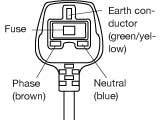British plug according to BS 1363 ATwo poles with earthing contact • with partly insulated contact pins |
The
British standard prescribes an earthed plug for three cores and a fuse
for all power connections (including Class II apparatus with two-core
connections). The British power outlets are provided with flaps in
front of the pole contacts to avoid foreign bodies from being inserted
into the holes. The flaps are opened by the earthing pin so that the
pole pins can make contact. The British plug/power outlet is described
in BS 1363. The plug fuse is described in BS 1362 and designed for
3/5/13 A. BS 1363 was released in 1962. Since that time, the previous
standard plugs/power outlets (BS 546) have been gradually replaced. The
system still exists in India, South Africa, Ireland, Hong Kong,
Malaysia and Singapore. Despite the approval according to BS 1363 the assembly plug is only approved as independent component. Thus, the user may connect any lead, irrespective of the approval or non-approval of the type. In Great Britain, the power supply is not divided into individual 16 A circuits downstream of the main fuse. There is no other fuse downstream of the 35 A main fuse. Therefore, the plug is provided with a fuse protecting the power network. |
British
spare fuses BS 1362 for British plugs:
Caution:Screwed British plugs and plugs of British standard connections are provided with a BS 1362 fuse. Such a fuse is about 2.5 cm long and thus differentiates from the international 5 x 20 mm and the North American 1/4” x 1-1/4” fuses. Great Britain is the only country in which fused power plugs are prescribed.This is necessary, because it is not common practice in Great Britain to protect a flat downstream of a main fuse by a division into several circuits with each 16 A or 10 A as it is prescribed in Germany. Also in Germany ,”ring circuits” are provided with several power outlets. Such a “ring “, however, is always protected with a 10 A or 16 A fuse. As the circuits downstream of the 35 A main fuse are not divided into individual circuits, all leads up to the consumer - or even inside the consumer, if it is not provided with an internal fuse, which is common practice - would have to be laid out to the current of the main fuse, unless the plug is provided with a fuse. |
Caution:The approval BS 1362 “Multi-purpose fuse for household appliances and similar applications (mainly for the use of power plugs)” refers to plugs approved according to BS 1363. For the standard of other fuses consult BS 4265 (1977).The fuse of an integral plug is located at the front side of the plug between phase and neutral. It is to protect the plug and the connecting cord - not the appliance. The rating of a replacement fuse for an integral plug has to comply with the specifications shown at the front side of the plug. In BS 1362, three different fuse ratings (3 A, 5 A, 10 A) are given preference. These fuse ratings are normally used by industry. A lower fuse rating may be used, e.g. for a 1.5 mm² lead a 13 A fuse is normally used in the plug, however, a 3 A or 5 A fuse may be used instead. Current and fuse ratings with reference to the conductor cross-section |
The figures in brackets indicate the fuse rating when using an integral plug for specific types of apparatus for which a 5 A fuse is required due to a high making current. |






